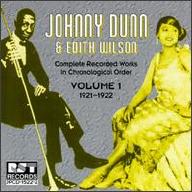Johnny Dunn
from Memphis, TN
February 19, 1897 - August 20, 1937 (age 40)
Biography
Before Louis Armstrong arrived in New York in 1924, Johnny Dunn was considered the top cornetist in the city. His staccato style, double-time effects and utilization of wah-wah mutes gave him notoriety for a time. Dunn had attended Fisk University in Nashville and had a solo act in Memphis before being discovered by W.C. Handy. He joined Handy's band in 1917 and during the next three years became known for his feature on Sergeant Dunn's Bugle Call Blues (which later became the basis for Bugle Call Rag). A pioneer with plunger mutes, Dunn's double-time breaks, with their inflexible and jerky rhythms, had a direct link to military bands. He recorded with Mamie Smith in 1920-1921, leaving in the latter year to lead his own Original Jazz Hounds. From 1921-1923, the cornetist recorded frequently, both with his own group and backing singer Edith Wilson. He joined Will Vodery's Plantation Orchestra in 1922, visiting Europe with the revue Dover to Dixie the following year. However, the Chicago musicians were much farther advanced than Dunn and once Louis Armstrong began influencing brassmen with his swinging, legato solos for Fletcher Henderson, Dunn was instantly out of date. After visiting Europe again (this time with the Blackbirds of 1926 show), Dunn briefly led his own big band and then in 1928 made his finest recordings, four numbers with Jelly Roll Morton and two with both James P. Johnson and Fats Waller on pianos. Strangely enough, he never recorded again, moving permanently to Europe, where he played with Noble Sissle in Paris, worked with his own group (the New Yorkers) mostly in Holland, and was largely forgotten before his early death. All of Johnny Dunn's recordings, other than his Mamie Smith sides, are on two RST CDs. ~ Scott Yanow, Rovi
Top Tracks
Albums
Videos
Close














